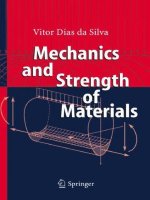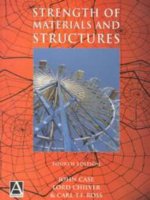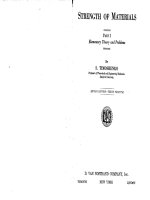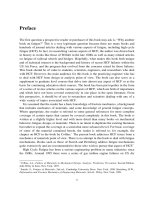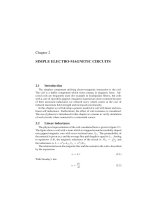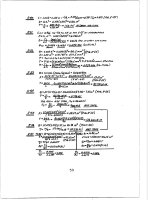Lecture Strength of Materials I: Chapter 2 - PhD. Tran Minh Tu
Bạn đang xem bản rút gọn của tài liệu. Xem và tải ngay bản đầy đủ của tài liệu tại đây (4.76 MB, 41 trang )
STRENGTH OF MATERIALS
1/10/2013
TRAN MINH TU - University of Civil Engineering,
Giai Phong Str. 55, Hai Ba Trung Dist. Hanoi, Vietnam
1
CHAPTER
2
Axial Force, Shear Force and
Bending Moment
1/10/2013
2
Contents
2.1. Introduction
2.2. Internal Stress Resultants
2.3. Example
2.4. Relationships between loads,
shear forces, and bending moments
2.5. Graphical Method for Constructing Shear
and Moment Diagrams
2.6. Normal, Shear force and
bending moment diagram of frame
1/10/2013
3
2.1. Introduction
- Structural members are usually classified
according to the types of loads that they
support.
- Planar structures: if they lie in a single
plane and all loads act in that same plane.
2.1.1. Support connections.
- Structural members are joined together in various ways depending on
the intent of the designer. The three types of joint most often specified
are the pin connection, the roller support, and the fixed joint
1/10/2013
4
2.1. Introduction
- Types of supports
- Pin support: prevents the translation at the
end of a beam but does not prevent the
rotation.
A
Idealized
HA
1/10/2013
V
A
5
2.1. Introduction
- Roller support: prevents the translation in
the vertical direction but not in the horizontal
direction, and does not prevent the rotation.
A
V
A
1/10/2013
6
2.1. Introduction
- Fixed (clamped) support: the bar can neither translate nor rotate.
A
HA
MA
V
A
1/10/2013
7
2.1. Introduction
1/10/2013
8
2.1. Introduction
2.1.2. Types of beams
1/10/2013
9
2.2. Internal Stress Resultants
In general, internal stress resultants
(internal forces) consist of 6 components
• Nz – Normal force
• Qx, Qy – Shear forces
• Mx, My – Bending moments
• Mz – Torsional moment
Planar structures: if they lie in a
single plane and all loads act in that
same plane => Only 3 internal stress
resultants exert on this plane (zoy) .
• Nz – axial force (N);
• Qy – shear force (Q);
• Mx - bending moment (M)
1/10/2013
Mz
Mx
x
Qx
z
NZ
My
Qy
y
Mx
x
z
NZ
Qy
y
10
2.2. Internal force Resultants
To determine the internal force resultants => Using the method of
sections.
N
Q
N
N
N
Q
N
1/10/2013
11
2.2. Internal force Resultants
Sign convention:
• Axial force: positive when outward
of an element, negative when
inward of an element
N
N
N
N
• Shear force: positive when acts
clockwise against an element,
negative when acts counterclockwise
against an element
• Bending moment: positive when
compresses the upper part of the
beam
and
negative
when
compresses the lower part of the
beam
1/10/2013
12
2.2. Axial, Shear and Moment diagram
2.1.3. Axial, Shear and Moment diagram
• Because of the applied loadings, the beams develop an internal
shear force and bending moment that, in general, vary from point to
point along the axis of the beam. In order to properly design a beam it
therefore becomes necessary to determine the maximum shear and
moment in the beam.
• One way to do this is expressing N, Q and M as the functions of their
arbitrary position z along the beam’s axis. These axial, shear and
moment functions can then be plotted and represented by graph called
the axial, shear and moment diagram
1/10/2013
13
2.2. Axial, Shear and Moment diagram
Moment diagram to be plotted by side, which it is in tension
N, Q
z
z
M
1/10/2013
14
2.3. Example
Example 2.1: Draw the shear
and moment diagram for
the beam shown in the
figure.
Solution:
1. Support reactions
M
B
C
VA
a
b
VB
VB a b Fa 0
A
VB
M
F
Fa
a b
VA a b Fb 0
VA
Fb
a b
Recheck:
1/10/2013
Y 0
15
2.3. Example
Segment AC
Section 1 – 1:0 z1 a
A
N 0
a
Y Q VA 0 Q VA
Fb
a b
VA
Fbz1
M
M
V
z
0
M
V
z
0
A 1
A 1
a b VA
1
F
1
C
2
b
M
Q
2
VB
M
N
z1
B
N
z2
Q
VB
Segment BC
Section 2 – 2:
0 z2 b
N 0
Y Q VB 0 Q VB
M
0
Fa
a b
M VB z2 0 M VB z2
1/10/2013
Faz2
a b
16
2.3. Example
F
Fb
AC : Q
a b
Fa
BC : Q
a b
Fbz1
AC : M
a b
C
VA
Fb
a+b
Faz2
BC : M
a b
a
b
VB
+
F
Q
N
Fa
a+b
Comment 1:
The section on which the
concentrated force acts, the
shear force diagram has
“jump”
1/10/2013
M
Fab
a+b
17
2.3. Example
Example 2.2: Draw the shear and
moment diagram for the beam
shown in the figure.
Solution:
1. Support reactions
1
q
1
VA
q
Or:
2
ql
M
V
.
l
A B 2 0
q.l
VB
2
ql 2
M B VA .l 2 0
VA
q.l
2
VB
M
q.l
VA VB
2
Symmetrically:
L
VA
z
N
Q
qz 2
M 0 M VA z 2 0
ql
q
M .z .z 2
2
2
2. Internal force resultant’s functions:
Segment 1-1
Y Q qz VA 0
1/10/2013
(0 ≤ z L)
Q
ql
q.z
2
18
2.3. Example
Q
ql
q.z
2
z 0 QA
z L QB
ql
q
M .z .z 2
2
2
M'
qL
qz
2
M '' q 0
q
qL
2
qL
2
L
VA
VB
qL/2
z 0 M A 0
z L M B 0
M ' 0 z
L
2
M max M z L / 2
qL2
8
Comment 2
The section on which the shear
force is equal to zero then the
bending moment is maximum.
+
Q
L/2
qL/2
1/10/2013
M
qL2/8
19
2.3. Example – example 2.3
1. Support reactions:
M
1
VB .(a b) M 0
M
VB
ab
M B VA.(a b) M 0
M
VA
ab
2. Stress resultants:
AC: Section 1-1 ( 0 ≤ z1 a)
M
Qy VA
ab
M x VA .z
A
M
2
C
a
VA
1
b
z1
VB
M
M
VA
2
Q
Q
z2
VB
Section 2-2 ( 0 ≤ z2 b)
Qy VA
1/10/2013
M x VB .z2
M
ab
20
2.3. Example – example 2.3
M
AC: ( 0 ≤ z1 a)
M
Qy VA
ab
M x VA .z1
C
a
b
VA
VB
BC: ( 0 ≤ z2 b)
M
Qy VA
ab
M x VB .z2
Q
M
(a+b)
Ma
(a+b)
Comment 3
The section on which the
concentrated moment acts,
the bending moment diagram
has “jump”
1/10/2013
M
(a+b)
M
M
Mb
(a+b)
21
2.4. Relationships between transverse loads, shear forces,
and bending moments
- Consider the beam shown in the figure,
which is subjected to an arbitrary loading.
The free-body diagram for a small
segment dz of the beam:
- Positive distributed load q(z): acts
upward on the beam
q(z) > 0
Y Q dQ Q q( z)dz 0
dQ
q( z )
dz
M M dM M (Q dQ)
dM
Q
dz
1/10/2013
dz
dz
Q 0
2
2
d 2 M dQ
q( z )
2
dz
dz
22
2.4. Relationships between loads, shear forces,
and bending moments
Application:
- Recognizing the type of Q and M diagrams when the distributed
load’s function is known, i. e if the distributed load’s function is ndegree, then the shear force’s function will be (n+1)-degree and the
bending moment function will be (n+2)-degree.
- The section, on which the shear force is equal to zero then the
bending moment is maximum.
- Determining Q, M on the arbitrary section, when knowing the value of
Q and M on the specific section.
•Qright = Qleft + Sq ( Sq – Area of distributed load diagram q)
•Mright = Mleft + SQ ( SQ – Area of shear force diagram Q)
1/10/2013
23
2.4. Relationships between loads, shear forces,
and bending moments
q
B
B
A
A
dQ q( z )dz
q(z)
Sq
QB QA Sq
z
A
Q
B
Q(z)
z
1/10/2013
B
A
A
dM Q( z )dz
SQ
A
B
M B M A SQ
B
24
2.4. Relationships between loads, shear forces,
and bending moments
1/10/2013
25
